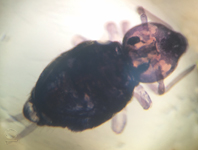Abstract
The genus Oaphantes is known from the West Coast of North America. Here we revise the genus which now includes three species, two of which are new: O. cryophilus n. sp. and O. prometheus n. sp. All Members of the genus Oaphantes show affinities for cave habitats. Oaphantes pallidulus is known from caves of the Coast Ranges of California and also from epigean records. Oaphantes cryophilus n. sp. is restricted to caves in the southern limit of its distribution in the Sierra Nevada Mountains of California, but in the north it is known from epigean records in Oregon, Washington and British Columbia. Oaphantes prometheus n. sp. is an eyeless troglobite endemic to a single cave in the Sierra Nevada of California. The distribution and relationships of the three species suggest an evolutive scenario likely due to climatic variations and affinities for colder conditions.
References
Aitchison, C.W. (1984) The phenology of winter-active spiders. Journal of Arachnology, 12, 249–271.
Arnedo, M.A., Hormiga, G. & Scharff, N. (2009) Higher-level phylogenetics of linyphiid spiders (Araneae, Linyphiidae) based on morphological and molecular evidence. Cladistics, 25, 231–262.
https://doi.org/10.1111/j.1096-0031.2009.00249.x
Banks, N. (1904) Some Arachnida from California. Proceedings of the California Academy of Sciences, Series 3, 3 (13), 331–376.
Briggs, T.S. & Ubick, D. (1988) Cavernicoles from Cave Gulch, Santa Cruz County. California Caver, 38 (2), 43–44.
Buckle, D.J., Carroll, D., Crawford, R.L. & Roth, V.D. (2001) Linyphiidae and Pimoidae of America north of Mexico: Checklist, synonymy, and literature. In: Paquin, P. & Buckle, D.J. (Eds.), Contributions à la Connaissance des Araignées (Araneae) d’Amérique du Nord, Fabreries, Supplément 10, pp. 89–191.
Chamberlin, R.V. & Ivie, W. (1936) Nearctic spiders of the genus Wubana. Annals of the Entomological Society of America, 29, 85–98.
https://doi.org/10.1093/aesa/29.1.85
Chamberlin, R.V. & Ivie, W. (1943) New genera and species of North American linyphiid spiders. Bulletin of the University of Utah, 33 (10), Biological Series, 7 (6), 1–39.
Cokendolpher, J.C. (2004) Cicurina spiders from caves in Bexar County, Texas. Texas Memorial Museum Speleological Monographs, 6. Studies on the cave and endogean fauna of North America, IV, 13–58.
Denis, J. (1949) Notes sur les Érigonides. XVI. Essai sur la détermination des femelles d’érigonides. Bulletin de la société d’histoire naturelle de Toulouse, 83, 129–158.
Elliott, W.R., Reddell, J.R., Rudolph, D.C., Graening, G.O., Briggs, T.S., Ubick, D., Aalbu, R.L., Krejca, J. & Taylor, S.J. (2017) The cave fauna of California. Proceedings of the California Academy of Sciences, Series 4, 64 (Supplement 1), 1–311.
Harvey, M.S. (2002) Short-range endemism among the Australian fauna: some examples from non-marine environments. Invertebrate Systematics, 16, 555–570.
https://doi.org/10.1071/IS02009
Hedin, M.C., Derkarabetian, S., Blair, J. & Paquin, P. (2018) Sequence capture phylogenomics of eyeless Cicurina spiders from Texas caves, with emphasis on US federally-endangered species from Bexar County (Araneae, Hahniidae). ZooKeys, 769, 49–76.
https://doi.org/10.3897/zookeys.769.25814
Hormiga, G. (2000) Higher level phylogenetics of erigonine spiders (Araneae, Linyphiidae, Erigoninae). Smithsonian Contributions to Zoology, 609, 1–160.
https://doi.org/10.5479/si.00810282.609
Lapointe, F.J. & Rissler, L.J. (2005) Congruence, consensus, and the comparative phylogeography of codistributed species in California. The American Naturalist, 166 (2), 291–299.
https://doi.org/10.1086/431283
Ledford, J.M., Paquin, P., Cokendolpher, J.C., Campbell, J. & Griswold, C.E. (2012) Systematics, conservation and morphology of the spider genus Tayshaneta (Araneae, Leptonetidae) in Central Texas Caves. ZooKeys, 167, 1–102.
https://doi.org/10.3897/zookeys.167.1833
Miller, J.A. (2005) Cave adaptation in the spider genus Anthrobia (Araneae, Linyphiidae, Erigoninae). Zoologica Scripta, 34, 565–592.
https://doi.org/10.1111/j.1463-6409.2005.00206.x
Paquin, P. (2004) A winter pitfall technique for winter-active subnivean fauna. Entomological News, 115 (3), 146–156.
Paquin, P., Dupérré, N., Buckle, D. & Lewis, J.J. (2009b) Oreonetides beattyi, a new troglobitic spider (Araneae: Linyphiidae) from Eastern North America, and re-description of Oreonetides flavus. Journal of Cave and Karst Studies, 71, 2–15.
Paquin, P., Dupérré, N., Cokendolpher, J.C., White, K. & Hedin, M. (2008) The fundamental importance of taxonomy in conservation biology: the case of the eyeless Cicurina bandida (Araneae: Dictynidae) of Central Texas, including new synonyms and the description of the male of the species. Invertebrate Systematics, 22, 139–149.
https://doi.org/10.1071/IS07044
Paquin, P., Dupérré, N. & Reddell, J.R. (2009a) A new troglophilic Agyneta from Colorado, the first description of the female of Agyneta llanoensis from Texas caves, and a classification of North American cave Linyphiidae (Araneae) as troglobites or troglophiles. Texas Memorial Museum Speleological Monographs, 7 (Studies on the cave and endogean fauna of North America), V, 37–56.
Rubinoff, D. & Holland, B.S. (2005) Between two extremes: mitochondrial DNA is neither the panacea nor the nemesis of phylogenetic and taxonomic inférence. Systematic Biology, 54, 952–961.
https://doi.org/10.1080/10635150500234674
Saaristo, M.I. (1973) Taxonomical analysis of the type-species of Agyneta, Anomalaria, Meioneta, Aprolagus, and Syedrula (Araneae, Linyphiidae). Annales Zoologici Fennici, 10, 451–466.
Saaristo, M.I. & Tanasevitch, A.V. (1996) Redelimitation of the subfamily Micronetinae Hull, 1920 and the genus Lepthyphantes Menge, 1866 with descriptions of some new genera (Aranei, Linyphiidae). Berichte des Naturwissenschaftlich-Medizinischen Vereins in Innsbruck, 83, 163–186.
Starrett, J. & Hedin, M. (2007) Multilocus genealogies reveal multiple cryptic species and biogeographical complexity in the California turret spider Antrodiaetus riversi (Mygalomorphae, Antrodiaetidae). Molecular Ecology, 16, 583–604.
https://doi.org/10.1111/j.1365-294X.2006.03164.x
Tu, L. & Hormiga, G. (2010) The female genitalic morphology of “micronetine” spiders (Araneae, Linyphiidae). Genetica, 138, 59–73.
https://doi.org/10.1007/s10709-009-9368-9
Ubick, D. (2001) Cavernicolous invertebrates of Cave Gulch, Santa Cruz County, California. Report to the Wilder Ranch State Park. California Academy of Sciences, San Francisco, California, 32 pp.


